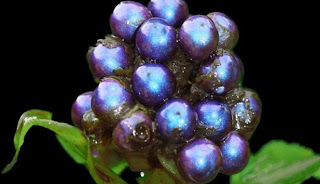 |
| Rind Pollia condensata |
Metallic colors will not fade for hundreds of years.UNIQUE
ALL - dazzling fruit that grows in the rain forest in the wilds of
Africa, has been named as the most colorful species of nature ever known
in the world of science.
He is the fruit of Pollia condensata, plants growing with a height of less than half a meter in Ethiopia, Angola, and Mozambique. The fruit is round, small, with a metallic color like beads.
The special of the fruit skin, bluish though, he actually has no blue pigment. Recent research published in the journal Proceedings of the National Academy of Sciences calls, instead of having the structure color, the skin reflects light waves of different sizes.
Each individual cells produce a variety of colors, which makes it like a painting Pointillism, a technique that is owned Impressionist painter arranging points into a complete picture. When viewed under a microscope, the skin appear to change color depending on the angle from which it is observed.
Cell layer thickness also determines the wavelength of the reflected light. Some cells have a thin layer that reflects the color blue, which produces a thicker green or red.
Dr Beverley Glover from the Department of Plant Sciences, University of Cambridge said, Pollia condensata has evolved intelligently.
"This little plant is fantastic, being able to make a fruit shiny, sparkly, multicolored, into signals that are attractive to birds in the vicinity, without throwing up photosynthesis just to feed the birds," he said.
As we know, plants need help other creatures, such as insects and birds to spread seeds. "This evolution is very smart."
Although men do not have any nutritional value, the birds attracted to the bright colors. It may be wonderful for decorating the nest, or to impress their partner.
What is also impressive, fruit color Pollia condensata not fade with time. The researchers found in fruit samples from herbarium collections of the 19th century, still shiny and colorful as it exists in nature.
| Rind Pollia condensata |
So inspiring
Not only cause admiration, Pollia condensata can be an inspiration to people. "By taking inspiration from nature, we can use our intelligence to take advantage of the material is abundant, inexpensive, and sustainable as cellulose," said Dr. Silvia Vignolini from the Department of Physics University of Cambridge.
He believes, as in Pollia condensata cellulose can be used to make dyes for industrial products. For example, using a cellulose-based nanostructures with structural colors instead of toxic dyes and food coloring. (Daily Mail, Sci-News | umi)
SOURCE: VIVA.co.id
Not only cause admiration, Pollia condensata can be an inspiration to people. "By taking inspiration from nature, we can use our intelligence to take advantage of the material is abundant, inexpensive, and sustainable as cellulose," said Dr. Silvia Vignolini from the Department of Physics University of Cambridge.
He believes, as in Pollia condensata cellulose can be used to make dyes for industrial products. For example, using a cellulose-based nanostructures with structural colors instead of toxic dyes and food coloring. (Daily Mail, Sci-News | umi)
SOURCE: VIVA.co.id

0 comments:
Post a Comment